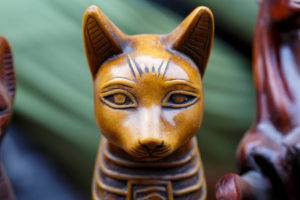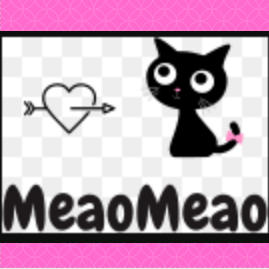
Cats as deities are most closely associated with ancient Egypt. The ancient
Egyptians had several feline gods and goddesses. Lions were said to guard the great god Ra during his nightly journey through the underworld. The Egyptians had a fascination with lions. They created their sphinx with the body of a lion and the head of Pharaoh.
Three lion goddesses existed in ancient Egypt. Sekhmet was a fierce and powerful
goddess. She was a war goddess who was sent by her father Ra to earth to destroy his enemies. She is usually depicted as a woman with the head of a lion. Another lion headed goddess was Tefnut whose name means moisture. She represented a primeval force of nature. The third lion goddess was Mafdet who was the goddess of protection.
Among her fierce sisters, gentle Bast may seem a bit out of place. Often shown as a graceful cat wearing bracelets a broad collar and earrings, Bast was the protectress of domestic cats and those who cared for them. Her principle gifts to the world were joy and pleasure. She was a much beloved household deity. Her principle temple was at Bubastis and was said to be one of the most beautiful and popular in all of Egypt. She had a secondary seat in Memphis as well. There is some evidence to believe that the ancient Egyptians believed that Bast and Sekhmet were actually two faces of the same divine force. Sekhmet representing the violent aspect of the divine, and Bast, the gentler qualities.
Egyptian children were often consecrated to Bastand placed under her protection.
Bast was considered a divine mother and was sometimes depicted with kittens. When a woman in ancient Egypt wanted to have children, she would often wear a bracelet or a necklace depicting the goddess Bast with kittens. The number of kittens shown with the goddess represented the number of children desired by the woman. Ancient Egyptians
seemed to consider cats to be the height of beauty. The styles of makeup they used,especially around the eyes, tended to give them a feline look. Cats were so highly regarded by the ancient Egyptians that the penalty for killing one was death. When a family cat died of accident or old age, its’ human family would go into mourning. They would shave their eyebrows off to show their grief. Cats were often mummified. One royal cat was buried in a marble coffin. The hieroglyphs on her coffin referred to her as “Lady Cat”.
Bast was said to be the wife of the god Ptah. Ptah was the creator god of the
universe. Ptah and Bast were said to have had a son, the fierce lion god Maahes. Maahes originated as a Nubian god. During the New Kingdom, his worship moved northward
where he was incorporated into the Egyptian pantheon as the son of Bast and Ptah. On becoming a divine mother, Bast became associated with the protectress of Lower Egypt, Wadjet. They became linked as Wadjet-Bast. A similar association was created in the
Upper Kingdom By the combination of Sekhmet and the Upper Kingdom protectress Nekhbet.
The constantly changing nature of Egyptian religion can be rather confusing. They had an inclusive attitude towards other gods and religions. The ancient Egyptians
freely adapted and adopted these others into their own cosmology. This attitude makes it difficult for modern readers to understand. Most of us have been raised in religions whose nature is highly exclusive. With an exclusive religion, outside influences are rejected or even actively repelled. The Egyptians, as demonstrated by the story of Bast
and Maahes, had a very different way at looking at religion.
